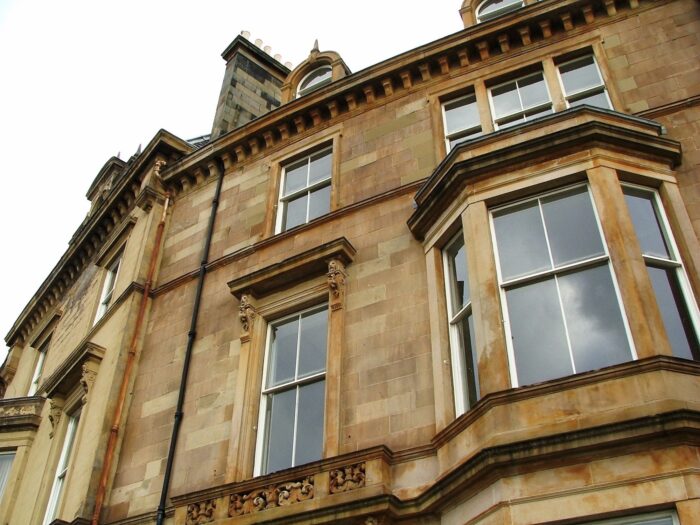Windows
Around 10% of the heat in our homes is lost through poorly insulated windows. Upgrading to energy efficient windows can help keep the heat in.

Upgrading your windows lets you keep the heat in for longer. This makes your home warmer whilst saving you money on your energy bills.
Energy efficient windows also have the added bonus of reducing condensation and insulating against noise from the outdoors.
In this article we’ll go through what you need to look out for when upgrading your windows.
What are energy efficient windows?
Like different types of home insulation, energy efficient windows help to slow down heat loss. This keeps your home warmer, for longer. You can tell how well a window keeps the heat in by checking its energy efficiency rating.
How do energy efficient windows work?
The energy efficiency of a window depends on:
- What materials it’s made from
- The size of the gaps between the panes
- What kind of gas (if any) the gaps are filled with
The most energy efficient panes use low emissivity (low-E) glass. This has a fine coating of metal oxide which reflects heat back into the home but doesn’t block out any sunlight.
The size of the gaps between the panes of glass also impacts energy efficiency. Filling these gaps with a gas such as argon or xenon can also improve performance.
When choosing new windows, it’s best to check their energy efficiency rating. This takes all the above factors into account and provides you with an easy to understand figure.
U-values for windows
When choosing new windows, one of the things to consider is the window’s u-value.
The u-value for windows measures how easily heat moves through the window. The lower the u-value, the less easily heat passes through the window.
Whilst u-values are helpful, they don’t give a full picture of the window’s energy efficiency. As with appliances like TVs and freezers, windows should come with an energy efficiency rating. The energy efficiency rating considers the u-value, but also looks at other factors which affect the window’s overall performance.
The energy efficient rating runs from A++ (most energy efficient) to E (least energy efficient).
Double glazing vs triple glazing
Double glazed windows have two panes of glass separated by a gap. Triple glazed windows have three panes and two gaps.
Comparing the energy efficiency ratings for double and triple glazed windows should give you a good indication of the difference in effectiveness.
Although triple glazing is generally more energy efficient than double glazing, it’s not simply a case of automatically choosing triple glazing. This is because:
Triple glazing is more expensive than double glazing
Depending on your budget, it might not be feasible to upgrade all your windows to triple glazing. There are currently no window grants in Scotland for upgrading to triple glazing, which may further impact affordability.
If your budget allows, you might consider installing a mix of double and triple glazed windows. You could choose triple glazed windows for the coldest rooms in your home, and double glazed for the rest.
Triple glazed windows have deeper frames than double glazed windows
When replacing your windows, you’ll need to make sure the new window frames aren’t too deep for the existing window space.
Standard double glazed windows have a depth of 28mm. Standard triple glazed windows have a depth of 36mm. The greater depth of triple glazed windows means they might not fit correctly in an existing property.
Window materials
From wood to UPVC, to aluminium, it’s possible to get very energy efficient windows in several different kinds of materials. Remember to check the energy efficiency rating when making comparisons.
As well as budget, you may want to consider how the window frame material compliments the character of your home, or if it complies with local planning permission.
UPVC (unplasticised polyvinyl chloride) is a type of plastic – usually white – that has been used in window construction since the 1980s.
Nowadays, UPVC is available in a range of colours. UPVC’s relative low cost, high durability and low maintenance make it the most popular type of window frame material across the UK.
Although they’re made from plastic, UPVC windows can be recycled.
Metal window frames are usually made from aluminium or steel. Like UPVC window frames, metal frames are strong, light, durable, and available in different colours.
Producing steel and aluminium is carbon-intensive, but metal window frames can be recycled.
Wooden window frames are usually the most environmentally friendly option when upgrading your windows.
For wooden frames to last, they need to be properly looked after. They are more likely to be damaged by weather or temperature if they’re not well maintained.
In conservation areas or listed buildings you may need to choose wood for your window frames to match the character of your property.
Composite window frames are wood frames which have a layer of aluminium or plastic coating on one (the exterior-facing) side. This means your windows are protected from the weather and extremes of temperature, but you still get the character of wooden frames inside your home.
New windows and planning permission
When thinking about replacing your windows it’s good to check if there are any restrictions on the changes you can make to your property. A good starting point is your local authority’s office for building standards.
There are also likely to be limits on what you can do with your windows if you live in a conservation area or a listed building. In conservation areas, any changes to your windows might need to be in keeping with the look of the building or the locality. If you live in a listed buildings, you may not be allowed to replace the windows. In either case, secondary glazing is often an option.
The mygov.scot website has a helpful tool which can help you work out whether you live in a conservation area or listed building. It also tells you who you’ll need to contact for different types of planning permission.
Secondary glazing
If your budget or building restrictions mean you can’t install double or triple glazing, then secondary glazing could be an option.
Secondary glazing adds an extra layer of glass inside your property, directly behind the existing window.
It’s possible to put in secondary glazing yourself with a DIY kit, or you might opt for a professional to install a more energy efficient and bespoke system.
Budget options are also available for secondary glazing. You may have seen cling-film like material applied to the inside of windows to create an extra layer of insulation. This type of secondary glazing has some impact on energy efficiency, but the material doesn’t tend to last very long.
Window grants in Scotland
Home Energy Scotland offer an interest-free loan of up to £4,500 to upgrade single glazing to double glazing. To find out more about the Home Energy Scotland Loan, simply call their freephone number on 0808 808 2282. An advisor will be able to talk you through the process.
Scottish grant funding for secondary glazing may be available through the Warmer Homes Scotland scheme. Information about the Warmer Homes Scotland scheme – including the eligibility criteria – is available on Home Energy Scotland’s website. Alternatively, you can call Home Energy Scotland on 0808 808 2282 and an advisor can let you know whether you qualify.

Changeworks delivers Home Energy Scotland in the south east and Highlands and Islands on behalf of the Scottish Government and Energy Saving Trust.
As well as providing free, impartial expert advice to thousands of people every month to help them to keep warm in their homes for less, they identify funding opportunities for households seeking to install energy efficiency measures.
For more information, give Home Energy Scotland a call on 0808 808 2282 or email and the team will be happy to help you.
Useful pages
Is this page useful?